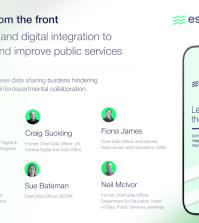Former UK GDS chief lists biggest digital challenges

The former head of the UK’s Government Digital Service this week called for major changes in how governments handle digital technologies, as he set out the findings of a report based on interviews with seven national digital leaders.
Speaking at the report’s launch webinar, Kevin Cunnington, who was director general of GDS 2016-19 and led the UK’s International Government Service until last year, argued that many countries encounter a similar set of obstacles in their digital operations. These include inadequate capital budgets, inappropriate project management systems, problems in recruiting senior digital specialists, and weak understanding and commitment among departmental leaders.
Cunnington carried out the research with Global Government Forum, using the ‘7 Lenses of Transformation’ project appraisal framework to interview top digital leaders based on four continents. The report, ‘Asking the experts: What do digital leaders need to succeed?’, maps out some of the biggest structural, cultural, funding and management challenges facing digital chiefs.
Introducing the research, Cunnington emphasised that while many countries face similar challenges, their responses must address their very diverse starting points and environments. “Everybody’s solution to the same problem is different,” he said. “Constitution, culture, politics, and legacy technology have a profound effect on where you start and how you can move forward.” Yet digital leaders have much to learn from each other, he said, with many relating similar experiences, achievements and frustrations.
Leading from the back
One key finding was that departments’ top leaders “often lack the understanding and commitment to drive digital transformation,” he said. Departmental digital chiefs “simply don’t have the authority” to resolve tensions over transformation plans “that benefit some stakeholders, [when] other stakeholders maybe don’t benefit at all or benefit in the much longer term,” explained Cunnington – and those at the very top too often prioritise safety and business continuity over digital transformation.
Cunnington quoted one interviewee who’d pointed out that departmental chiefs have “spent their entire careers being reflexively liability-conscious and risk-averse – because that’s how they got to be [departmental leaders] – and [chief digital and information officers are] asking them to do the unthinkable and embrace change. It is the wrong cohort to try to get to lead such an operation.” There are few incentives for top leaders to drive through transformation projects, he added, and plenty of disincentives.
“I’ve always been struck by the fact that we call our most senior people ‘permanent secretaries’ [in the UK] – and permanent implies continuity, not change,” he said. Titles such as deputy minister and chief executive are used elsewhere, he added, “and I think that’s better: it joins a few of the dots for me.”
Digital destinations need route maps
The report also highlighted weaknesses in strategic planning, with digital strategies too often setting out ambitious visions while failing to put in place the performance targets, funding, tools and systems required to deliver them. “If I’m being honest, [many countries’] digital visions were a little ‘samey’,” he said. “Best practice in this area was all about how you created the plan to implement the strategy, not about the strategy and vision itself.” Cunnington’s favourite interviewee quote, he added, was that too many strategies “‘contain nothing objectionable, and also nothing actionable’.”
Yet unless these strategies catalyse major reforms, governments will always struggle to build the foundations required for digital transformation. These include “a single digital identity for each citizen” – a capability that Cunnington called “the Rosetta Stone of digital: if you can create this digital identity, you can move forward and produce joined-up services very quickly, because you can link datasets together… If you can’t, you end up getting really quite stuck”.
This is “the great digital divide”, he explained: a “haves and have-nots element is emerging”. Countries able to base their digital ID on an existing national ID system are making faster progress, while other nations “have been struggling to create a proxy digital identity, for a whole variety of reasons.”
Rules and resources
On funding, Cunnington said the research identified a “sense in many governments that we put a lot of money in[to digital] five, ten years ago, and actually our priority isn’t digital any more”. A reluctance to make capital investments in transforming legacy services and back office systems is holding back progress, he said, with some finance departments feeling that “we’ve done digital – but of course that’s not true, you’ve never quite done digital.” In many cases, he added, rules around business planning, budgeting, procurement and governance also hamper transformation schemes and need updating to suit the needs of digital technologies.
On the positive side, Cunnington noted that national digital workforces have grown rapidly in size, skills and capabilities. “Ten years ago, all of us would have said the most presenting problem in government was getting hold of good digital resource to implement services. Five years ago, it was still a big problem,” he said. “Now, none of us think that is a problem at all.”
On workforce issues, the remaining problems lie at very senior levels, where pay levels are often far lower than those available in private business. “The problem was particularly acute in countries with strong domestic industries and sectors… particularly in conjunction with countries where civil servants’ pay is kind of linked to the pay of their political leaders,” he said, challenging “the old adage that we shouldn’t pay somebody more than we pay the prime minister.”
But where constrained pay makes it difficult recruit or retain really good digital leaders, he warned, other costs arise. “Where we’ve used interims, that hasn’t been successful, because they don’t have the mandate [or] the longevity” to drive change, he said. “Where we’ve tried to over-promote people, most people feel that’s put them in a difficult position of trying to [lead] some very large programmes without experience. And candidly, the mistakes you make outweigh the benefits of saving money on salary.”
The next steps for digital transformation
Few governments have scratched the surface in realising the potential of digital, Cunnington argued. “Even some of the most mature countries have so much more to do on issues like digital identity and creating single records of citizens,” he said. “There’s a huge journey ahead of us.”
That journey becomes less arduous if national digital leaders can learn from one another along the way, he added, noting that he’s always regretted not engaging more fully with his peers overseas while he led GDS. If “you have a conversation with someone who’s tackling exactly the same problem as you, sometimes in the same way or with the same constraints, not only is that quite therapeutic, but actually I can see a way forward now that I wouldn’t have seen before,” he commented. “Part of what we’re trying to do at GGF is to provide real value by getting people to have those conversations.”
Building on the new research, Cunnington explained, GGF will be holding a series of workshops for digital leaders working in key fields of strategy and delivery. These will include some aimed at officials in any country – focusing on ‘vision and planning’ and ‘people and skills’ – and parallel workshops for those on each side of the ‘digital divide’ around ID verification: one will serve civil servants from countries with an existing national ID system, and one from those without.
What’s more, Cunnington will take the report’s messages to other key groups. One “trend that weaves its way” through the report, he said, is that “where CDIOs have control, they feel they’ve done a good job; they feel they’ve made progress. Where they are dependent on others… they don’t feel similar levels of progress have been made.” As the report makes clear, CDIOs need the support of other leaders to realise their goals – recruiting finance chiefs to reform procurement and spending approval systems, for example, and heads of civil service to encourage more active engagement by departmental leaders.
“Part of the value-add of Global Government Forum is that we can have those conversations in a non-personal way, with the chief financial officers and CEOs of government and say: ‘There is a consensus coming out here’,” he said. So Cunnington will present the research findings at the Global Government Summit, which serves civil service’s national leaders, and its Government Finance Summit – where the audience comprises heads of finance departments and treasuries.
You can read the full report on our website, or watch Kevin Cunnington set out the report’s findings at our launch webinar. Learn more about the workshops for digital leaders, and apply to attend, via our Digital Leaders Research and Events Programme page.
























Another part of the problem is that the destination (single digital identity) is not what the majority of tech savvy voters want.
Digital control provides an avenue for future exploitation of the subjects/citizens – no matter what the current motivation is.
As NIN said “bow down before the one you serve, you’re going to get what you deserve”